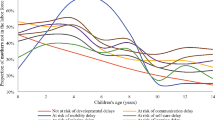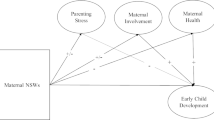Abstract
This study focused on the associations between timing and intensity of maternal employment in early childhood and the developmental outcomes of young Canadian children. We conducted a secondary analysis of data from the Canadian National Longitudinal Survey of Children and Youth using multiple linear regression. We tested the associations between mothers’ employment in the first four years of children’s lives and motor and social development of zero to 4-year-old-children and receptive language of 4 and 5-year-old-children. We also examined the association between working more than 20 h a week during the first 2 years of children’s lives and children’s outcomes. We found that mothers who returned to work when their children were between 0 and 4 years old had enhanced motor and social development in comparison to children of mothers who did not work during this time. Additionally, findings showed that relative to children of mothers who worked 20 h or less a week in the first 2 years of their children’s lives, in particular between 12 and 17 months, children of mothers who worked more than 20 h had lower receptive language scores at 4 and 5 years of age. These findings have implications for maternity and parental leave policy in Canada.
Similar content being viewed by others
References
Baker, M. (2006). Restructuring family policies. Convergences & divergences. Toronto: University of Toronto Press.
Baker, M., & Milligan, K. (2008). Maternal employment, breastfeeding, and health: Evidence from maternity leave. Journal of Health Economics, 27, 871–887.
Baker, P. C. & Mott, F. L. (1989). NLSY child handbook 1989: A guide and resource document for the National Longitudinal Survey of Youth 1986 child data. Columbus, Ohio: The Ohio State University, Center for Human Resource Research.
Baydar, N., & Brooks-Gunn, J. (1991). Effects of maternal employment and child-care arrangements on preschoolers’ cognitive and behavioral outcomes: Evidence from the children of the national longitudinal survey of youth. Developmental Psychology, 27, 932–945.
Belsky, J., & Eggebeen, D. (1991). Early and extensive maternal employment/child care and 4-6 years olds socioemotional development: Children of the national longitudinal survey of youth. Journal of Marriage and the Family, 53, 1083–1099.
Bernard, J. Y., De Agostini, M., Forhan, A., Alfaiate, T., Bonet, M., Champion, V., Kaminski, M., de Lauzon-Guillain, B., Charles, M., & Heude, B., EDEN Mother-Child Cohort Study Group. (2013). Breastfeeding duration and cognitive development at 2 and 3 years of aged in the EDEN mother-child cohort. The Journal of Pediatrics, 163, 36–42.
Blau, F. D., & Grossberg, A. J. (1992). Maternal labor supply and children’s cognitive development. The Review of Economics and Statistics, 74, 474–481.
Boyd, W., Thorpe, K., & Tayler, C. (2010). Preferences of first-time expectant mothers for care of their child: “I wouldn’t leave them somewhere that made me feel in secure.” Australasian Journal of Early Childhood, 35, 4–12.
Boyd, W., Walker, S., & Thorpe, K. (2013). Choosing work and care: Four Australian women negotiating return to paid work in the first year of motherhood. Contemporary Issues in Early Childhood, 14, 168–178.
Bronars, S. G., & Grogger, J. (1994). The economic consequences of unwed motherhood: Using twin births as a natural experiment. American Economic Review, 84, 1141–1156.
Brooks-Gunn, J., Han, W., & Waldfogel, J. (2002). Maternal employment and child cognitive outcomes in the first three years of life: The NICHD study of early child care. Child Development, 73, 1052–1072.
Brooks-Gunn, J., Han, W., & Waldfogel, J. (2010). First-year maternal employment and child development in the first 7 years. Monographs of the Society for Research in Child Development, 75, 1–147.
Bureau of Labor Statistics, United States Department of Labor (2011). NLSY79 children and young adults. http://www.bls.gov/nls/nlsy79ch.htm.
Carlson, K. B. (2012). Career and family: Why is it still so hard for women to have both. National Post, p. 1. http://news.nationalpost.com/2012/10/13/career-and-family-why-is-it-still-so-hard-for-women-to-have-both/.
Chatterji, P., & Frick, K. D. (2005). Does returning to work after childbirth affect breast feeding practices? Review of Economics of the Household, 3, 315–335.
Choi, Y., Bishai, D., & Minkovitz, C. S. (2009). Multiple births are a risk factor for postpartum maternal depressive symptoms. Pediatrics, 123, 1147–1154.
Cooksey, E., Joshi, H., & Verropoulou, G. (2009). Does mothers’ employment affect children’s development? Longitudinal and Life Course Studies, 1, 95–115.
Dunn, L. M., & Dunn, L. M. (1981). Peabody picture vocabulary test (revised). Circle Pines, Minnesota: American Guidance Service.
Eichler, L. (2013). Secrets of the happiest working moms. Together Magazine, p. 1. http://togethermoms.ca/secrets-of-the-happiest-working-moms/.
Ferrao, V. (2010). Women in Canada: A gender-based statistical report. Ottawa: Statistics Canada. Paid work (Catalogue No. 89-503-X).
Gaudet, S., Cooke, M., & Jacob, J. (2011). Working after childbirth: A lifecourse transition analysis of Canadian women from the 1970s to the 2000s. Canadian Review of Sociology, 48, 153–180.
Goldberg, W. A., Prause, J., Lucas-Thompson, R., & Himsel, A. (2008). Maternal employment and children’s achievement in context: A meta-analysis of four decades of research. Psychological Bulletin, 14, 77–108.
Greenstein, T. N. (1993). Maternal employment and child behavioral outcomes: A household economics analysis. Journal of Family Issues, 14, 323–354.
Han, W., Waldfogel, J., & Brooks-Gunn, J. (2001). The effects of early maternal employment on later cognitive and behavioral outcomes. Journal of Marriage and Family, 63, 336–354.
Harris, N. (2008). Women’s reflections on choosing quality long day care in a regional community. Australian Journal of Early Childhood, 33, 42–49.
Harvey, E. (1999). Short-term and long-term effects of early parental employment on children of the national longitudinal survey of youth. Developmental Psychology, 35, 445–459.
Hertzman, C. (2000). The case for an early childhood development strategy. Isuma, 1, 11–18.
Hill, J. L., Waldfogel, J., Brooks-Gunn, J., & Han, W. (2005). Maternal employment and child development: A fresh look using newer methods. Developmental Psychology, 41, 833–850.
Huerta, M. C., Adema, W., Baxter, J., Corak, M., Deding, M., Gray, M. C., & Waldfogel, J. (2011). Early maternal employment and child development in five OECD countries. OECD Social, Employment, and Migration Working Papers (No. 118). OECD Publishing, Paris, France.
Huston, A. C. (2001). Child care and child development. International Encyclopedia of the Social and Behavioral Sciences, 1, 1682–1686.
Jean, A. B., Goldman, D. P., & Joyce, G. (2011). Association between the birth of twins and parental divorce. Obstetrics and Gynecology, 117, 892–897.
Kuhlthau, K., Kahn, R., Hill, K. S., Ghanasekaran, S., & Ettner, S. L. (2010). The well-being of parental caregivers of children with activity limitations. Maternal and Child Health Journal, 14, 155–163.
Laughlin, L. (2011). Maternity leave and employment patterns of first-time mothers: 1961-2008. Washington: U.S. Census Bureau.
Lethbridge, L. (2010). Two SAS bootstrapping programs. http://www.shrugonline.ca/downloads/20101125/Bootstrapping.ppt.
Lombardi, C. M., & Coley, R. L. (2014). Early maternal employment and children’s school readiness in contemporary families. Developmental Psychology, 50, 2071–2084.
Lombardi, C. M., & Coley, R. L. (2016). Early maternal employment and children’s academic and behavioral skills in Australia and the United Kingdom. Child Development. doi:10.1111/cdev.12588.
Lucas-Thompson, R. G., Goldberg, W. A., & Prause, J. (2010). Maternal work early in the lives of children and its distal associations with achievement and behavior problems: A meta-analysis. Psychological Bulletin, 136, 915–942.
Mistry, R. S., Biesanz, J. C., Taylor, L. C., Burchinal, M., & Cox, M. J. (2004). Family income and its relations to preschool children’s adjustment for families in NICHD Study of Early Child Care. Developmental Psychology, 40, 727–745.
Moss, P. (2013). International review of leave policies and related research 2013. http://www.leavenetwork.org/lp_and_r_reports/.
Mott, F. L., Baker, P. C., Ball, D. E., Keck, C. K., & Lenhart, S. M. (1995). The NLSY children 1992: Description and evaluation. Revise March 1998. Columbus, Ohio: The Ohio State University, Center for Human Resource Research.
NICHD Early Child Care Research Network. (2001). Nonmaternal care and family factors in early development: An overview of the NICHD study of early child care. Applied Developmental Psychology, 22, 457–492.
The Norwegian Labour and Welfare Administration (2017a). Parental benefit—general information. (n.d.a.) https://www.nav.no/In+English.
The Norwegian Labour and Welfare Administration (2017b). Can I work while claiming parental benefit? (n.d.b.) https://www.nav.no/English/English/Can+I+work+while+claiming+parental+benefit%3F.241312.cms.
O’Connor, C., & Wright, A. (2013). Female career progression and maternity leave: An Irish exploration. Business and Economic Research, 3, 322–343.
Parcel, T. L., & Menaghan, E. G. (1994). Early parental work, family social capital, and early childhood outcomes. The American Journal of Sociology, 99, 972–1009.
Pluess, M., & Belsky, J. (2010). Children’s differential susceptibility to effects of parenting. Family Science, 1, 14–25.
Poe, G. (1986). Design and procedures for the 1981 child health supplement to the National Interview Survey. Hyattsville, Maryland: National Centre for Health Statistics. Working paper services.
Rønsen, M., & Kitterød, R. H. (2012). Entry into work following childbirth among mothers in Norway: Recent trends and variation. Oslo: Statistics Norway.
Ruhm, C. J. (2004). Parental employment and child cognitive development. The Journal of Human Resources, 39, 155–192.
Samek, D., Koh, B. D., & Rueter, M. A. (2013). Overview of behavioral genetics research for family researchers. Journal of Family Therapy and Review, 5, 214–233.
Service Canada (2014). Employment insurance maternity and parental benefits. http://www.servicecanada.gc.ca/eng/ei/types/maternity_parental.shtml#much.
Shonkoff, J. P., & Phillips, D. A. (2000). From neurons to neighborhoods: The science of early childhood development. Washington: National Academies Press.
Slaughter, A. (2012). Why women can’t have it all. The Atlantic, p. 1. http://www.theatlantic.com/magazine/archive/2012/07/why-women-still-cant-have-it-all/309020/.
Statistics Canada. (1996). National longitudinal survey of children: Survey instruments for 1994-95 data collection—cycle. Ottawa: Statistics Canada 1.
Statistics Canada. (2006). Low income cut-offs for 2005 ad low income measures for 2004. (Catalogue no. 75F0002MIE). Ottawa: Statistics Canada.
Statistics Canada. (2010). National longitudinal survey of children and youth, cycle 8, user guide. Ottawa: Statistics Canada.
Statistics Canada. (2017). Microdata user guide, national longitudinal survey of children and youth, cycle 6, September 2004 to June 2005. Ottawa: Statistics Canada. (n.d.).
Waldfogel, J. (2001). International policies toward parental leave and child care. The Future of Children, 11, 98–11.
Waldfogel, J., Han, W., & Brooks-Gunn, J. (2002). The effects of early maternal employment on child cognitive development. Demography, 39, 369–392.
Acknowledgments
This research was supported by funds to the Canadian Research Data Centre Network (CRDCN) from the Social Science and Humanities research Council (SSHRC), the Canadian Institute for Health Research (CIHR), the Canadian Foundation for Innovation (CFI) and Statistics Canada. Although the research and analysis are based on data from Statistics Canada, the opinions expressed do not represent the views of Statistics Canada or the Canadian Research Data Centre Network (CRDCN).
Author information
Authors and Affiliations
Corresponding author
Ethics declarations
Conflict of Interest
The authors declare that they have no competing interest.
Ethical approval
All procedures performed in studies involving human participants were in accordance with the ethical standards of the institutional and/or national research committee and with the 1964 Helsinki declaration and its later amendments or comparable ethical standards.
Informed consent
Informed consent was obtained from all individual participants included in the study.
Electronic supplementary material
Rights and permissions
About this article
Cite this article
Lightbody, T.K., Williamson, D.L. The Timing and Intensity of Maternal Employment in Early Childhood: Implications for Canadian Children. J Child Fam Stud 26, 1409–1421 (2017). https://doi.org/10.1007/s10826-017-0668-x
Published:
Issue Date:
DOI: https://doi.org/10.1007/s10826-017-0668-x




